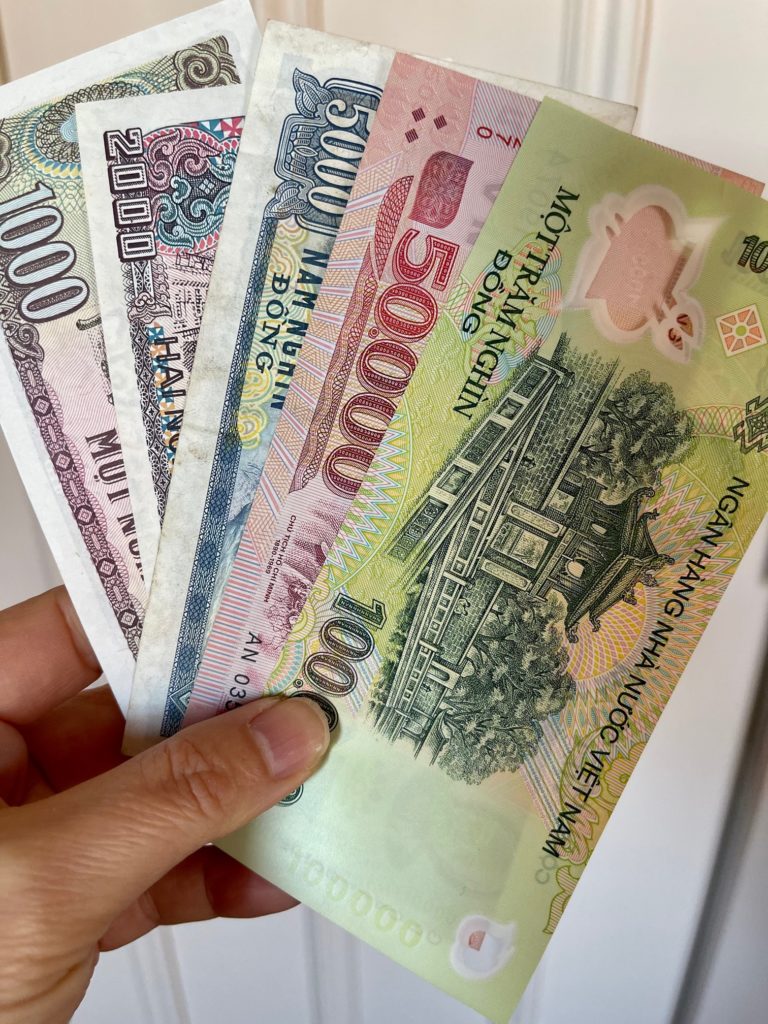Vietnamese Currency Posted by Kandle Dart on Mar 1, 2021 in Culture, Economy, Finance, History, Vocabulary
The đồng, sign ₫ or đ; code VND is the current Vietnamese currency, issued by the State Bank of Vietnam (Ngân hàng Nhà nước Việt Nam).
The current average exchange rate of 1 USD is around 23,000.00 VND
Money Units
- Coins: 200₫, 500₫, 1.000₫, 2.000₫, 5.000₫. Note that coins are not commonly used and may not be accepted in regular exchange.
- Banknotes: 100₫, 200₫, 500₫, 1000₫, 2000₫, 5000₫, 10.000₫, 20.000₫, 50.000₫, 100.000₫, 200.000₫, and 500.000₫
Keep in mind that Vietnam uses a decimal comma as a decimal separator and a period sign for the thousand separators in digital groupings. For example, five hundred thousand is written as 500.000,00
Current use of Banknotes
Many developed countries these days have become cashless societies to various degrees with the use of electronic transactions, bank cards, and bank checks. Vietnam, however, still heavily relies on cash, especially in the countryside and rural areas, where banks are not available. Daily transactions are basically cash exchanges. People pay everything in cash. It is common to see people carry a thick stack or even a whole bag of bank notes to make payment for common purchases.
If you are a foreigner, getting used to the currency units can be quite confusing because there are too many zeroes in the bills. Do not freak out if you hear that someone makes ten million đồng (10.000.000đ) a month! That person only makes around four hundred thirty dollars ($430 USD). That is not a salary for a millionaire!
As you can see, the 100₫, 200₫, and 500₫ banknotes are just around $0.0043, $0.009, $0.022 respectively. Their values are so minimal that the 100₫, 200₫ banknotes are almost obsolete. The 500₫ is on the brink of disappearing as well.
Recognize the Bills
The Vietnamese banknotes come in different sizes and colors. It is confusing if you are not used to it. Except for the 100₫ bill, all have the image of Ho Chi Minh in the front, so it is not that helpful. However, it is easier to differentiate them if you look at the backside since each denomination has a different image. Although the color is different on each bill, some are similar. See below for the description.
- 200₫ (around $0.0043 USD): A tractor in an agricultural scene. Bronze color.
- 500₫ (around $0.02 USD): Port of Hải Phòng with fishing boats. Pinkish red color.
- 1.000₫ (around $0.043 USD): Elephant assisting men with timbering in Tây Nguyên. Greyish brown with some blue color. This one is similar to the 2,000₫
- 2.000₫ (around $0.09 USD): Nam Định Textile Factory, one of the oldest textile factory in Indochina. Greyish brown with some blue color, similar to the 1,000₫
- 5.000₫ (around $0.22 USD): Trị An Hydroelectric Plant on Đồng Nai Blue color.
- 10.000₫ (around $0.43 USD): Offshore oil rig on Bạch Hổ oil field, Vũng Tàu. Yellowish brown color.
- 20.000₫ (around $0.87 USD): Chùa Cầu, an old Japanese covered bridge in Hội An. Blue color.
- 50.000₫ (around $2.17 USD): Nghênh Lương Đình and Phu Văn Lâu, the historic pavilions in the Imperial Citadel, city of Huế. Pinkish and yellow color.
- 100.000₫ (around $4.33 USD): Văn Miếu – Quốc Tử Giám (Hanoi’s Temple of Literature), the first college in Vietnam. Greenish color.
- 200.000₫ (around $8.67 USD): Hạ Long Bay, the world’s natural heritage. Brownish red with green color.
- 500.000₫ (around $21.67 USD): The birthplace of Ho Chi Minh in Nghệ An Province. Blue tonel color. This is the largest bill value. With this, you can fill up your stomach with a good meal at a restaurant for both lunch and dinner!

Build vocabulary, practice pronunciation, and more with Transparent Language Online. Available anytime, anywhere, on any device.




